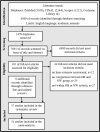Knee Extensor Structure and Function in Children, Adolescents, Adults, and Older Adults With Obesity: A Systematic Review and Meta-Analysis
- PMID: 40387558
- PMCID: PMC12404886
- DOI: 10.1111/obr.13949
Knee Extensor Structure and Function in Children, Adolescents, Adults, and Older Adults With Obesity: A Systematic Review and Meta-Analysis
Abstract
Objective: This study aims to evaluate the association between obesity and both absolute and relative measures of knee extensor muscle structure and contractile function across different age groups, including children, adolescents, adults, and older adults.
Methods: A search for potential studies was performed in four electronic databases. Data were meta-analyzed using a random-effects model for our primary outcomes of knee extensor structure (muscle size and quality) and function (maximal force/torque, rapid torque, and fatigue) and compared between those with or without obesity in each age group.
Results: The findings indicate that obesity significantly increases absolute measures of knee extensor maximal contractile function and muscle size. However, obesity was associated with a decrease in relative measures of maximal and rapid contractile function and muscle quality. The association of obesity with these muscle characteristics varied by age group, with the effects on knee extensor structure and function diminishing with age.
Conclusions: This systematic review and meta-analysis demonstrate that while obesity enhances absolute knee extensor muscle size and maximal force/torque, it detrimentally affects relative muscle function and quality, particularly related to activities of daily living. These effects are less pronounced in older adults, suggesting that age modulates the impact of obesity on muscle structure and function. The findings underscore the importance of interventions targeting the improvement of relative muscle function and quality in individuals with obesity. Further research is necessary to better understand these relationships and to develop more effective intervention strategies for obesity.
Registration: This protocol was prospectively registered in the Open Science Framework (DOI: 10.17605/OSF.IO/ZGUK6).
Keywords: muscle; muscle function; muscle quality; muscle structure; obesity.
© 2025 The Author(s). Obesity Reviews published by John Wiley & Sons Ltd on behalf of World Obesity Federation.
Conflict of interest statement
The authors declare no conflicts of interest.
Figures








Similar articles
-
Dose-Response Relationships of Resistance Training in Healthy Old Adults: A Systematic Review and Meta-Analysis.Sports Med. 2015 Dec;45(12):1693-720. doi: 10.1007/s40279-015-0385-9. Sports Med. 2015. PMID: 26420238 Free PMC article.
-
Effects of Strength Training Using Unstable Surfaces on Strength, Power and Balance Performance Across the Lifespan: A Systematic Review and Meta-analysis.Sports Med. 2015 Dec;45(12):1645-69. doi: 10.1007/s40279-015-0384-x. Sports Med. 2015. PMID: 26359066 Free PMC article.
-
Associations Between Measures of Balance and Lower-Extremity Muscle Strength/Power in Healthy Individuals Across the Lifespan: A Systematic Review and Meta-Analysis.Sports Med. 2015 Dec;45(12):1671-92. doi: 10.1007/s40279-015-0390-z. Sports Med. 2015. PMID: 26412212 Free PMC article.
-
Physical exercise training interventions for children and young adults during and after treatment for childhood cancer.Cochrane Database Syst Rev. 2016 Mar 31;3(3):CD008796. doi: 10.1002/14651858.CD008796.pub3. Cochrane Database Syst Rev. 2016. PMID: 27030386 Free PMC article.
-
Physical exercise training interventions for children and young adults during and after treatment for childhood cancer.Cochrane Database Syst Rev. 2013 Apr 30;(4):CD008796. doi: 10.1002/14651858.CD008796.pub2. Cochrane Database Syst Rev. 2013. Update in: Cochrane Database Syst Rev. 2016 Mar 31;3:CD008796. doi: 10.1002/14651858.CD008796.pub3. PMID: 23633361 Updated.
References
-
- WHO , Obesity and Overweight (World Health Organization, 2021, Accessed August 6, 2021), https://www.who.int/news‐room/fact‐sheets/detail/obesity‐and‐overweight.
-
- CDC , BMI for Children and Teens (Centers for Disease Control and Prevention, 2021, Accessed August 10, 2021), https://www.cdc.gov/obesity/childhood/defining.html.
Publication types
MeSH terms
Grants and funding
LinkOut - more resources
Full Text Sources
Medical

